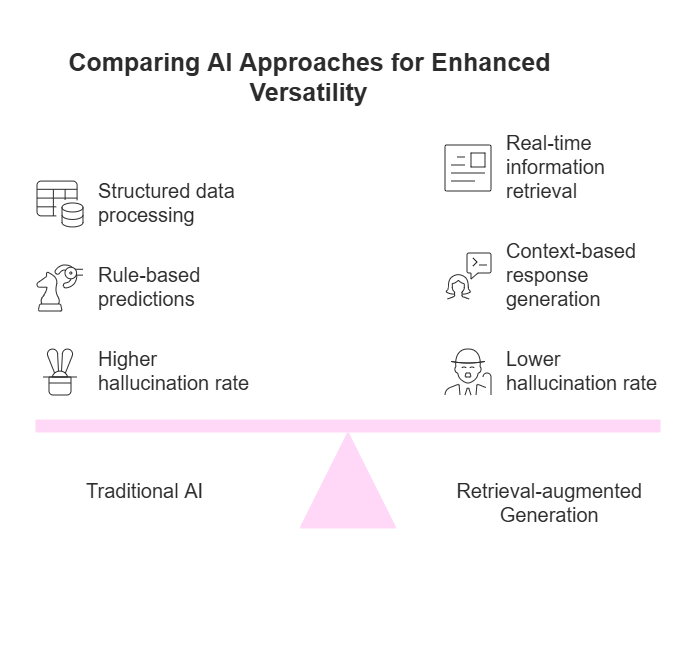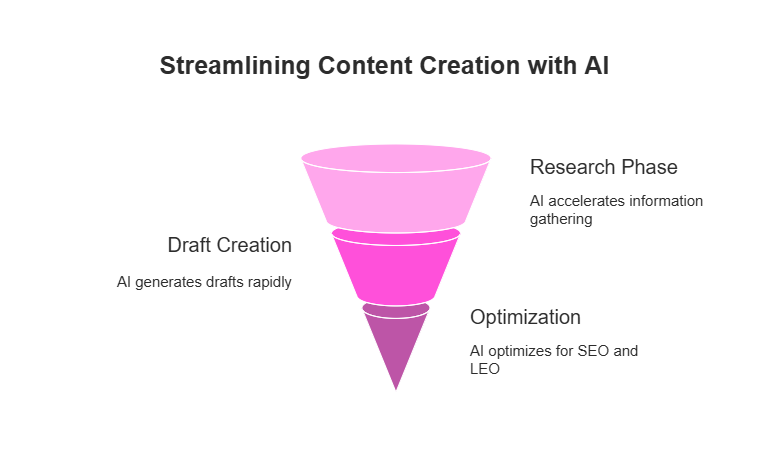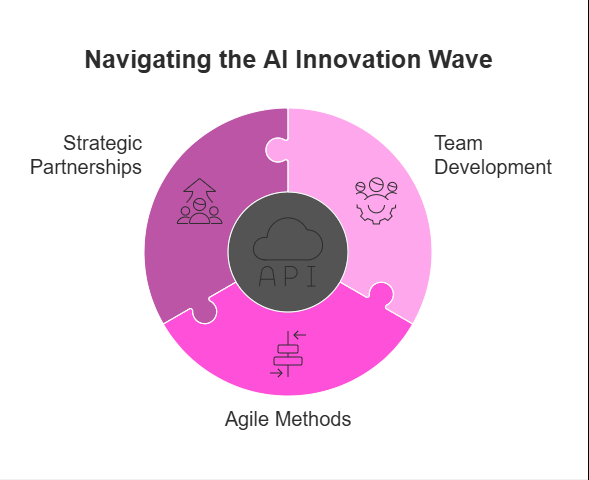This article explores how generative AI transforms business operations across multiple departments. Unlike traditional AI that analyzes existing data, generative AI creates new content and solutions. Companies implementing these technologies report significant productivity gains and cost savings.
For many organizations, generative AI offers a competitive edge when properly implemented. This technology works best as a complement to human expertise rather than a replacement. The right approach balances innovation with accuracy while addressing data quality and integration challenges.
Transforming Business Operations with Generative AI
Businesses implementing Retrieval-Augmented Generation technology can reduce AI hallucinations by up to 30%, marking a significant reliability breakthrough for enterprise AI adoption. This advancement represents just one way generative AI transforms modern business operations across industries.
Unlike traditional AI systems that analyze existing patterns, generative AI creates entirely new content, designs, and solutions based on learned information. From marketing teams crafting personalized campaigns to product developers accelerating innovation cycles, these technologies drive measurable business outcomes.
Forward-thinking companies report substantial returns, like a retail chain achieving 48% higher conversion rates through AI-powered customer interactions. Platforms like Cubeo AI now make these capabilities accessible without coding expertise, allowing businesses of any size to harness generative AI’s competitive advantages.
Understanding Generative AI in Business Context
Many leaders struggle to grasp how different AI types apply to their operations. As we explore this technology landscape, generative AI stands out by creating new content rather than just analyzing existing data. In a way, this shift powers everything from content creation to problem-solving across multiple departments.
Our research shows that companies using understanding generative AI solutions achieve notable operational improvements. More than half of AI models in business will become domain-specific by 2027. This represents a dramatic increase from just 1% in 2023. Such rapid adoption comes from generative AI’s unique ability to process unstructured information.
Reliability concerns often slow down AI implementation for executives. Advanced techniques like Retrieval-Augmented Generation help solve this challenge effectively. These systems ground AI responses in verified information sources.
The combination of creative capabilities with knowledge databases results in more trustworthy applications. For many organizations, this balance between innovation and accuracy drives successful AI adoption strategies.
What Makes Generative AI Different from Traditional AI
Traditional AI recognizes patterns within structured data and follows set rules for predictions. In contrast, Retrieval-augmented Generation creates entirely new outputs through a different approach. This technology combines learned patterns with real-time information retrieval, which makes it more versatile.
The RAG approach functions through several distinct steps:
• Documents transform into searchable chunks
• User questions trigger relevant information retrieval
• AI generates responses based on retrieved context
This architecture cuts hallucination rates by up to 30% compared to standard models.

The Business Value Proposition of Generative AI
The economic impact of these technologies appears substantial. McKinsey on generative AI value estimates they could unlock $2.6 trillion annually in marketing and sales alone. Early adopters report productivity jumps between 20-30% in research and operations teams.
One global insurance company achieved 40% faster claims processing after implementing these models. These results highlight several key investment priorities:
Key areas for strategic investment include:
• Tools that augment knowledge workers
• Systems enhancing customer experiences
• Platforms automating and optimizing processes
We recommend building cross-functional teams with executive support for implementation. Data privacy and integration challenges remain significant hurdles. Companies addressing these issues systematically gain substantial competitive advantages. The technology works best when enhancing human capabilities rather than replacing them completely.
Top Generative AI Applications in Customer Operations
Customer expectations keep rising every day. Service teams face mounting pressure to deliver more with less. Generative AI provides powerful solutions for this challenge. Recent data shows that by the end of 2025, customer service AI will power 95% of customer interactions. This technology actually boosts productivity by up to 400%.
We can leverage these technologies across multiple touchpoints for better results. AI tools create consistent yet personalized experiences from first contact through post-purchase support. The systems handle routine inquiries without human intervention. This approach, in some respects, frees our human agents to tackle complex issues requiring emotional intelligence.
What makes these applications so valuable? Their ability to learn from each interaction improves service quality over time. We see significant cost savings alongside higher satisfaction scores. Successful implementation, however, requires careful planning around data quality. System integration and performance measurement also need our attention.
AI-Powered Customer Service Automation
Modern AI chatbots engage in natural conversations at any hour. These systems understand context pretty well. They remember previous interactions and respond with appropriate tone.
MIT Sloan on AI use recommends a three-step approach for high-impact use cases:
• Map existing processes and pain points
• Evaluate feasibility based on data availability
• Pilot solutions with clear metrics
An insurance company applied this framework with impressive results. Their AI assistant now handles policy questions and claim status updates. This implementation reduced call center volumes by 30%, which is quite remarkable.
Personalized Customer Experiences at Scale
Generative AI transforms how we deliver personalized experiences to millions of customers simultaneously. The technology analyzes behavior patterns to create tailored content. Customer preferences guide these recommendations in real time.
E-commerce platforms now generate product descriptions highlighting features relevant to each shopper. Financial firms customize educational content based on individual financial goals. In both cases, the AI adapts messaging to match preferences, and honestly, the results speak for themselves.
A retail chain implemented hyper-personalization across their digital channels with great success. Their system adjusts website layouts and product recommendations dynamically. This approach led to a 48% jump in conversion rates, which is extremely impressive by industry standards.
Implementation Challenges and Solutions
Data quality stands as the primary hurdle for effective AI deployment. Systems trained on incomplete information produce disappointing results. We should establish robust governance frameworks before implementation to avoid these pitfalls.
Legacy system integration presents another common obstacle for many organizations. Decades of customer data often sit in disparate systems. Middleware solutions that connect these systems offer practical paths forward without complete overhauls.
Measuring return requires tracking both quantitative and qualitative metrics. According to ROI metrics for AI, we can expect an average ROI of 3.7x when investing in generative AI. Productivity improvements typically range from 15% to 30%.
Transforming Marketing and Sales with Generative AI
Marketing teams struggle daily with content demands. Sales departments race to close deals faster. In a way, both face similar pressures in our competitive landscape. Generative AI steps in as a solution to these common challenges. Actually, about 61.4% of marketers have already started using AI marketing tools, and this number grows each year.
This technology transforms three key areas of business operations. Content creation becomes dramatically faster. Campaign personalization reaches new levels of relevance. Sales forecasting gains remarkable accuracy. Each application solves specific problems that previously limited team effectiveness. Marketing groups can now produce in hours what once took days. Sales teams get deeper insights into prospect behavior.
Companies see quick returns after implementing these systems. Cost savings appear almost immediately. Revenue growth follows shortly after. Industry research suggests AI-driven analytics improve marketing effectiveness by 20-30%. These results translate to real business value that we can measure in dollars, not just theoretical benefits.
Content Creation and Optimization
Modern content must satisfy two different audiences simultaneously. Human readers need engaging material. AI systems require structured information. SEO and LEO optimization with Cubeo AI addresses both needs effectively. SEO focuses on traditional search rankings. LEO ensures content appears in AI-generated responses.
Creating professional content typically takes around six hours per blog post. AI tools compress this workflow significantly:
• Research phase: Minutes instead of hours
• First draft creation: Seconds rather than days
• Optimization for both humans and AI: Automated completely
Email campaigns using these techniques achieve impressive results. Experian discovered that personalized emails created through AI systems generated transaction rates six times higher than standard approaches. This kind of improvement makes a compelling case for adoption.

Personalized Marketing Campaigns
Competitive advantage now depends on personalization capabilities. AI-driven campaign personalization has become essential, with 79% of business leaders making it a strategic priority. The technology lets marketers create individual experiences across channels without increasing workload proportionally.
Teams using AI for campaign development report time savings up to 90%. This efficiency shift allows more focus on strategy instead of execution details. One retail company, for instance, automated their email sequence generation. Their engagement rates jumped 42% while production time dropped from weeks to days.
Ethical considerations remain important when implementing these systems. Successful organizations maintain transparent AI policies. They prioritize human-AI collaboration rather than full automation. Regular training ensures teams use the technology responsibly. These practices build customer trust while maximizing benefits.
Sales Process Enhancement with AI
Lead qualification consumes enormous amounts of sales team time. AI lead qualification systems analyze prospect behavior to identify promising opportunities. This analysis helps sales professionals focus efforts where they’ll have the greatest impact.
McKinsey research shows generative AI can boost sales productivity by 3-5%. This improvement comes through automating administrative tasks and enhancing customer communications. Sales professionals seem to agree with these findings. About 61% believe AI helps them serve customers better while selling more efficiently.
Pipeline forecasting becomes more reliable with AI analysis. These systems spot patterns human managers might miss. The result? More accurate revenue predictions. One software company implemented AI forecasting and reduced prediction variance by 28%. This improvement enabled more confident resource allocation and better strategic planning.
Generative AI in Product Development and R&D
R&D teams worldwide face growing pressure to innovate faster while managing costs. AI in product development offers solutions by shortening timelines and expanding creative possibilities. McKinsey research shows these technologies could add between $2.6 trillion to $4.4 trillion in annual value across sectors.
Benefits go beyond just saving time. Teams using generative AI R&D tools report better design quality and innovation outcomes. These systems often explore design spaces humans might overlook. They suggest novel approaches to stubborn challenges that traditional methods miss.
Product developers find AI particularly valuable for complex problems. The technology handles massive datasets and identifies patterns too subtle for human detection. In a way, this partnership between human creativity and machine processing power creates optimal results.
Accelerating Innovation Cycles
Traditional product development typically follows step-by-step paths. AI-powered approaches enable teams to explore multiple design iterations at once. This parallel processing can cut development cycles by 30-50% in many cases.
Engineers now generate dozens of virtual prototypes before physical production begins. A medical device company recently cut their design validation from months to weeks. They used generative simulation tools to test variations simultaneously rather than sequentially.
Industry-Specific Applications
In healthcare, generative AI analyzes medical imaging data to suggest potential diagnoses. These systems identify patterns across thousands of scans. Clinicians receive evidence-based recommendations that improve diagnostic accuracy.
For automotive design, similar technologies optimize vehicle components. AI algorithms generate designs for weight, strength, and manufacturability. Human engineers might never consider some of these innovative configurations.
Financial modeling benefits too, with generative models stress-testing portfolios. Banks run thousands of market scenarios quickly. This approach spots vulnerabilities that conventional methods might miss.
Measuring R&D Efficiency Improvements
Successful implementation of generative AI R&D requires clear metrics. Organizations should track:
• Time-to-market reduction
• Resource utilization improvements
• Quality indicators (defect rates, customer satisfaction)
A Deloitte study found 91% of organizations expect productivity gains from AI. About 56% focus specifically on efficiency improvements. Companies establishing baseline measurements before implementation can actually quantify these benefits more accurately.
Smart teams set realistic expectations for AI in product development. They understand that results vary by industry and application. The most successful organizations view AI as a complement to human expertise rather than a replacement.
Implementing Generative AI in Your Business
Growing enthusiasm for generative AI exists across industries, yet 75% of leaders struggle with adoption challenges. Strategic planning, organizational readiness, and ethical guardrails form the foundation of successful implementations. Companies taking methodical approaches achieve better outcomes than those rushing deployment without proper preparation. In fact, businesses need more than just technology purchases to succeed in this space.
The generative AI market will reach $62.72 billion by the end of 2025, with a remarkable 41.53% annual growth through 2030, according to recent statistics. This rapid expansion creates both opportunities and implementation hurdles for organizations of all sizes. We must assess our readiness, develop structured roadmaps, and establish governance frameworks before deployment begins. Too often, companies jump into AI without these foundational elements.
Successful implementations typically follow three phases: assessment, planning, and responsible execution. Each phase addresses specific challenges while building toward sustainable AI integration. Organizations skipping these steps often face unexpected costs, integration difficulties, and potential reputational risks. As a matter of fact, rushing through implementation rarely produces optimal results.
Assessing Your Business Readiness
efore implementing generative AI, we should evaluate our organization’s current capabilities and gaps. A survey found 64% of businesses expect AI to boost efficiency while 25% use it to address staffing shortages. Our assessment must examine three key areas to ensure proper preparation. Well, starting with a thorough evaluation saves significant resources later.
From concept to reality, successful AI projects require cross-functional teams combining technical and business expertise. We need to determine whether data scientists, AI engineers, and DevOps specialists should come from internal teams or external partners. The right team composition often determines project success or failure.
Technology readiness involves examining current infrastructure, data quality, and integration capabilities. We should consider:
• Cloud computing resources
• Data storage and processing systems
• API connectivity between systems
• Security protocols for AI applications
Benchmark current operational efficiency to establish baseline metrics for measuring AI impact after implementation. In some respects, these measurements provide the clearest picture of AI’s business value over time.
Building a Generative AI Roadmap
Our roadmap should begin with clear business objectives. Harvard Business Review reports that 31% of generative AI use cases focus on personal and professional support, while 18% relate to content creation. Alignment with specific organizational needs matters more than following generic implementation patterns. Basically, customization drives better results than one-size-fits-all approaches.
Prioritize high-impact use cases based on three factors:
• Potential business value
• Technical feasibility
• Implementation complexity
Companies achieving 90% workflow improvements with generative AI typically begin with narrowly defined projects delivering quick wins. These initial successes build momentum for more ambitious initiatives. Each project should include specific milestones, success metrics, and responsible stakeholders for accountability.
Ethical Considerations and Responsible Implementation
Ethical AI implementation starts with robust data governance protocols. The pros and cons of using AI tools must be carefully weighed, particularly regarding privacy and security concerns. We should develop clear guidelines for data collection, storage, and usage that comply with relevant regulations. Actually, these protocols protect both customers and the organization.
Human oversight remains essential for responsible AI deployment. Establishing review processes where humans validate AI outputs before they affect customers or critical business decisions balances efficiency with quality control. This human-in-the-loop approach minimizes risks while maximizing benefits.
Monitor AI systems continuously for bias, errors, and drift from expected performance. Regular audits should examine:
• Output quality and accuracy
• Potential discriminatory patterns
• Alignment with organizational values
These safeguards protect business reputation while maximizing the benefits of generative AI technologies. In a way, ethical implementation creates sustainable competitive advantage beyond mere efficiency gains.
Future Outlook: The Evolving Landscape of Generative AI in Business
Where will generative AI take us next? The technology moves forward at amazing speed. In some respects, its capabilities now exceed what seemed possible just months ago.
Three key changes will shape AI applications soon. Multi-modal systems will mix text, image, and audio into single platforms. No-code tools will make AI available to more teams. Hybrid agent designs will combine rules with creative flexibility.
We should prepare with purpose rather than react to changes. Companies building basic AI skills now gain advantages as these tools mature. This preparation needs both technical systems and team readiness.
Emerging Trends to Watch
The way AI agents evolve represents a major shift on our horizon. Simple Reflex AI baseline systems using if-then rules will gradually join with advanced generative models. This combined approach pairs reliable responses with creative problem-solving.
No-code platforms continue growing in popularity. These tools help business users without tech backgrounds create custom AI solutions. They feature visual interfaces and ready-made templates.
Multi-modal AI systems process various information types at once. These create more natural human-machine conversations. They understand context across different data forms, which really enhances their usefulness.
Preparing for the Next Wave of Innovation
Team development should top our priority list. According to Harvard Business Review, generative AI outlook reveals 31% of use cases now focus on personal and professional support. Our teams need skills to use these capabilities well.
Agile methods become even more vital in fast-changing AI environments. We should establish:
• Cross-functional innovation teams
• Quick testing processes
• Ongoing learning systems
Strategic partnerships can speed up innovation while sharing development costs. These team-ups provide access to expert knowledge. Such expertise would be hard to build internally, so partnerships make sense.

Strategic Recommendations for Business Leaders
Begin with focused pilot projects that solve specific business problems. These limited tests provide valuable learning experiences. They also demonstrate clear benefits to stakeholders.
Success measures should balance numbers with qualitative feedback. Too often, we focus just on metrics and miss important insights from users.
Ethical considerations must start at the beginning, not as afterthoughts. We need clear guidelines for responsible AI use that address:
• Data privacy and security
• Bias detection and prevention
• Clear decision-making processes
Infrastructure investments should follow a staged approach matching your AI maturity. Start with basic elements like data systems before expanding company-wide. This careful approach reduces risks while maximizing return on investment.



